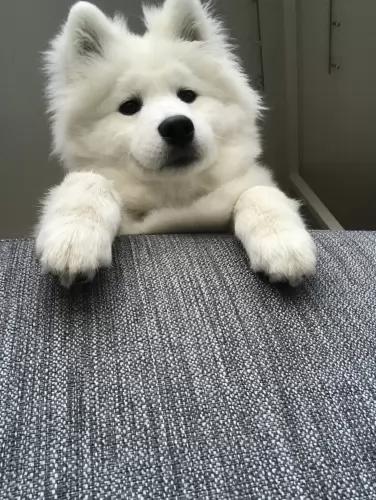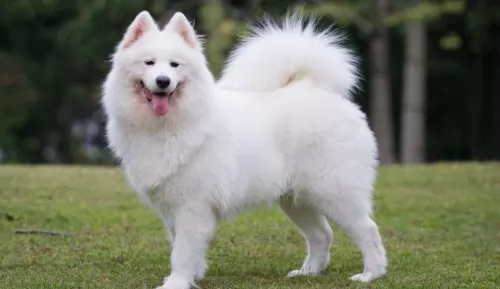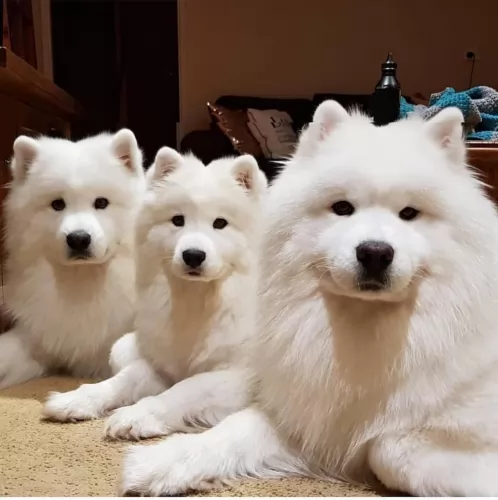 MyDogBreeds
MyDogBreedsSamoyed is originated from Russia but Podenco Galego is originated from Spain. Samoyed may grow 8 cm / 4 inches higher than Podenco Galego. Samoyed may weigh 15 kg / 34 pounds more than Podenco Galego. Both Samoyed and Podenco Galego has same life span. Both Samoyed and Podenco Galego has same litter size. Samoyed requires Moderate maintenance. But Podenco Galego requires Low maintenance
 The Samoyed is a large breed of dog; a spitz-type dog, with a thick, double-layer coat. The dog was used to help with herding and to also haul sledges for the Siberian Samoyede people.
The Samoyed is a large breed of dog; a spitz-type dog, with a thick, double-layer coat. The dog was used to help with herding and to also haul sledges for the Siberian Samoyede people.
The Samoyed has been used in polar expeditions, including Sir Ernest Shackleton's journey to the Antarctic. They’ve put up with a lot of hardships on these journeys and some of them have lost their lives on these expeditions.
The first standard for the breed was adopted in England in 1909, and in 1923 the original Samoyed Club of America was established.
The Galego is an ancient sighthound breed of hunting dog from Spain.
Unfortunately, like most of the Podencos, they have been badly treated in Spain. People who own them have also used them for rabbit hunting.
It is thought that these dogs may have been bred with other sighthounds over the centuries. The dog may well be the most recognized breed in Spain, but its isn’t recognized by the World Canine Organization. There are however breeders wanting to make it an official breed.
 The Samoyed is a large herding dog standing at between 48 to 60cm in height and weighing 16 – 30kg. He has a thick, double layer coat that is silvery white.
The Samoyed is a large herding dog standing at between 48 to 60cm in height and weighing 16 – 30kg. He has a thick, double layer coat that is silvery white.
The top layer is fairly long and coarse. The dog sheds heavily once or twice a year, but the dog is described as being hypoallergenic.
The ears of the dog are typical spitz-like – erect. The eyes of the dog are almond in shape and while they are usually brown, they can sometimes be blue too. The tail is long and curls over the dog’s back. When these dogs sleep in the snow, you might notice the tail is folded so that it covers the dog’s nose.
The Samoyed is a friendly dog, to such an extent that you wouldn’t call him a good watchdog. They’re friendly dogs with happy expressions on their faces. They make great family pets and will get on well with children as well as other dogs in the home.
Like all dogs, the Samoyed will need early training and socialization to make him obedient and well rounded. He is intelligent and can easily learn a few basic commands.
The Podenco Galego is a medium sized dog standing at between 42 to 52cm in height and weighing roughly from 10 to 15kg.
The Podenco Galego is similar in appearance to greyhounds, being tall ad slender with short smooth coats There are varieties with longer coats. The dog is lean and agile with bright, intelligent eyes.
The coat is thick and dense and available in a variety of colours which include brindle and white. The ears are erect and the tail long.
Loving and loyal to his human family, it is terrible that this dog that has been so abused by humans should still wag his tail and offer a paw of friendship.
He is a gentle dog that loves to play with children. He is intelligent too and if you train him and have him socialized he can be a pleasure to have around.
He is the kind of dog that can adapt to life in the city or the countryside so long as he is exercised regualarly. He has well developed senses and is an alert dog, active and independent, responding well to training.
 The Samoyed is a gentle, easy going dog that gets on well with everyone, loving children and being prepared to be friendly towards other dogs too.
The Samoyed is a gentle, easy going dog that gets on well with everyone, loving children and being prepared to be friendly towards other dogs too.
His friendliness makes it that he doesn’t make a good watchdog. He is intelligent and can be trained to obey basic commands.
He loves plenty of exercise, after all he has always been a working dog. Apart from the coat which will require quite a bit of upkeep, the Samoyed is prepared to come into your home and make you a splendid pet and companion.
Your Podenco Galego is an energetic dog who will rely on you to provide him with lots of daily action.
He is a strong willed dog and will do well with a confident firm, patient and consistent owner. He becomes attached to his human owner and he plays well with gentle, kind, respectful children in the home.
He is a quiet dog too that doesn’t irritate with constant barking. He has had a raw deal from the people in Spain but he is still willing to show you what he can offer you – ongoing friendship and love, and that’s a lot more than lots of humans can offer you.
 Dogs can get diabetes just like people can. Diabetes is becoming more common in dogs as people try and feed their dogs ‘treats’ such as chocolates, biscuits and ice-cream.
Dogs can get diabetes just like people can. Diabetes is becoming more common in dogs as people try and feed their dogs ‘treats’ such as chocolates, biscuits and ice-cream.
Fortunately diabetes is manageable. Certainly, if you discover signs of diabetes in your pet, get him to the vet. The typical symptoms of diabetes in dogs are increased urination, increased thirst and weight loss. Cataracts and blindness can also occur.
Glaucoma is when there is increased pressure in the eye. It can be hereditary or secondary where there is decreased fluid in the eye because of other eye diseases. Symptoms include pain and even vision loss. It can be treated surgically or with eye drops.
This is an inherited condition in dogs where the thighbone doesn't fit properly into the hip joint. Some dogs will even have lameness in both rear legs. The vet will want x-rays to diagnose hip dysplasia. Unfortunately arthritis can also develop.
These dogs are ancient dog breeds not particularly well known outside the Iberian Penninsula. They are strong, robust dogs,resistant to disease. However, they can succumb to some of the more common dog diseases even though they are so resistant to diseases.
With proper care, a Podenco hardly ever gets sick and can live to be 12 – 14 years of age.They also have a low probability of developing degenerative diseases such as hip dysplasia. This is a joint disease common in other breeds.
Dogs can get allergies which can be very upsetting for both you and your dog.Your dog scratches and licks and can’t find relief. The most common area affected are the ears, underarms, the eye area, groin and paws. You will need to get your pet to the vet as he can become frantic with the itching and pain.
 The coat of the dog is super thick and in the Spring, the dog sheds a lot. Samoyed dog owners will need to be regular with their brushing routine with these dogs as the coat can easily tangle. Some people just prefer to get their Samoyed to a professional groomer.
The coat of the dog is super thick and in the Spring, the dog sheds a lot. Samoyed dog owners will need to be regular with their brushing routine with these dogs as the coat can easily tangle. Some people just prefer to get their Samoyed to a professional groomer.
This is a working dog, used to working hard in all kinds of conditions. He doesn’t take kindly to being bored with nothing to do and he howls and barks till you take him on a walk. He requires regular exercise such as hiking, ball games, running and swimming. It is why this dog isn’t suited to life on a small property in the city. He requires a large garden or farm and lots of exercise.
If you want your Samoyed to be healthy so that you’re not constantly at the vet, provide him with top quality food. It is always useful and convenient having commercially manufactured food but you want to vary the diet just a bit by providing some homemade food too.
If you boil chicken, brown rice or pasta and spinach, sweet potatoes and carrots in a pot you can chop it all up and freeze it and feed portions twice a week to your dog. Warmed up it can be added to his dry kibble and be a wonderful tasty treat for him. Every now and then you can also include some raw meat which can be beneficial for his skin. Ensure there is always a bowl of fresh, cool water within his reach.
Your Galego is a lean, muscular dog, and he wants lots of exercise. He won’t be content with just a walk every day, but will want ball and frisbee games or joining in with you as you as you go running or jogging.
To ensure your dog stays as robust and healthy as he is, make sue he gets quality food. If you do opt to feed him a commercially manufactured dog food, make sure it isn’t one of the low quality foods that are filled with bad ingredients and which can actually make your dog sick.
Apart from a high quality dry kibble, provide him with some tasty homemade food too. Boiled chicken, brown rice and pasta, sweet potatoes, carrots and spinach, all chopped up and added into the kibble once in a while will be a wonderful treat for your pet.He will be totally satisfied with this. Try and give him some raw meat occasionally as this helps to stave off irritating skin problems.. Make sure he always has a bowl of fresh, cool water close by.
Make sure his vaccinations are up to date.
Provide him with a dry, warm comfortable place to sleep.
Brush him twice a week. Check inside his ears for infections.Trim his nails and look inside his mouth for bad teeth which can play havoc with his health.
Take him to the vet whenever he is sick.